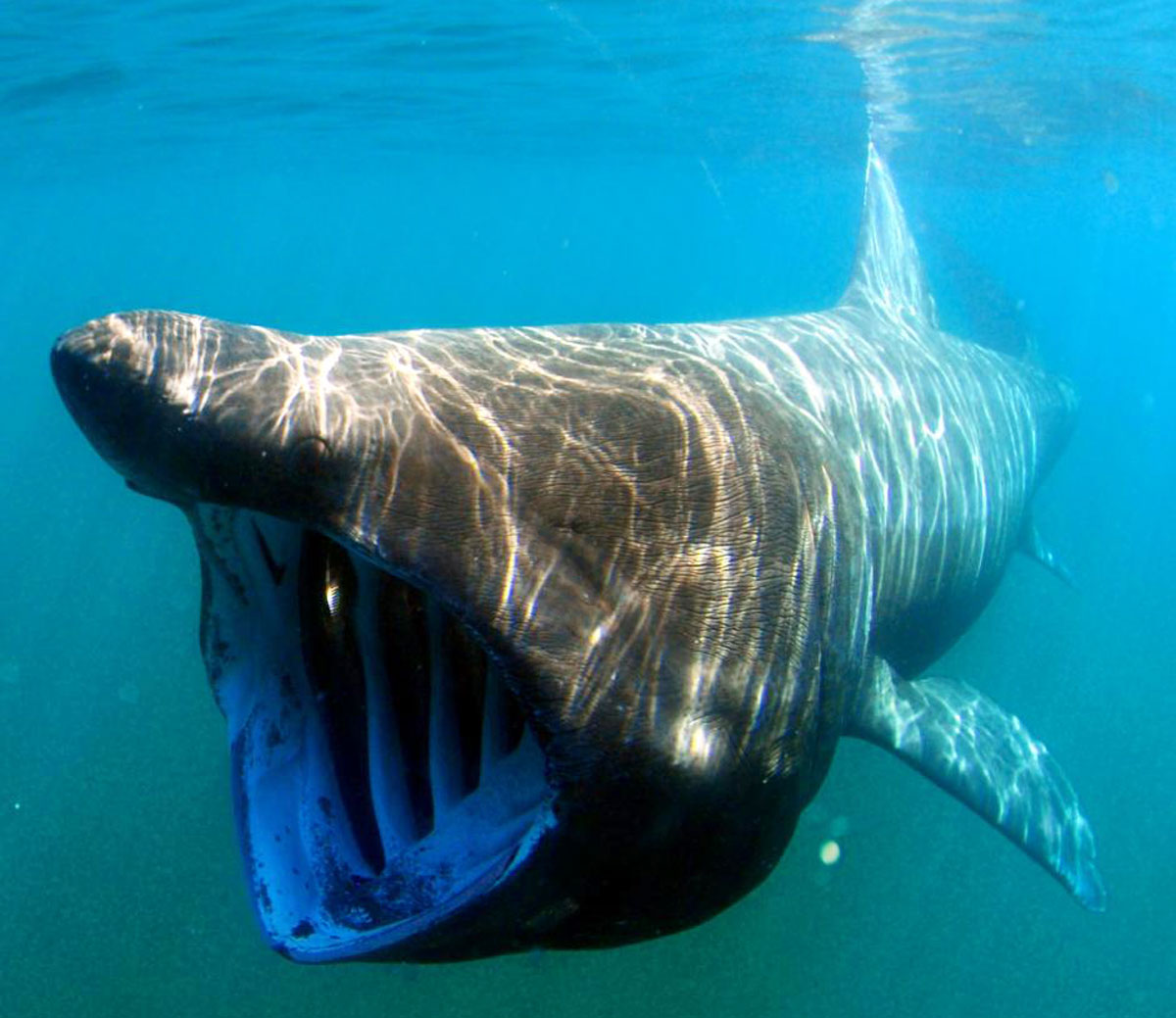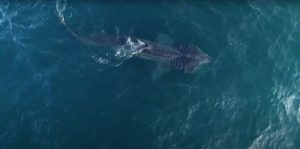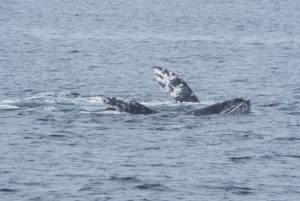“Basking sharks,” Sean Van Sommeran says repeatedly, “are the most endangered large shark in the Pacific Ocean.”
And, as if to emphasize the point, we can’t find them. Monterey-based squid fisherman Kevin Reynolds reported seeing a huge school recently, the Monterey Herald reported in July, but Pelagic Shark Research Foundation Executive Director Van Sommeran, his research assistant Curtis Craver, and I are on the search to see them with our own eyes. Gray water chops against the sides of Craver’s boat, the Sea Gayle, as we motor through the fog in Monterey Bay. The Santa Cruz Mountains long since disappeared into the clouds, and while there’s plenty of life in Monterey Bay today – sea otters, molas, and egg jellyfish – there’s nothing at all like a school of 20-foot-long fish, mouths agape, enormous gill slits flared, basking at the surface. Craver pilots the boat as Van Sommeran scans the horizon with a pair of binoculars. “Any radio traffic you heard of?” he asks Craver, “Anything good?”
Nothing.
The sharks were once common off Monterey, so it’s not entirely surprising that they might appear here, says NOAA Fisheries Research Biologist Heidi Dewar. They’ll come inshore, particularly when the coastal upwelling is strong and their krill prey is abundant in the nutrient-rich waters. But it’s nonetheless rare, Dewar says, to see as many sharks in one place as were reported in July. And what that sighting might mean is tough to say: there’s almost no information about basking shark population size in the Eastern Pacific. According to a detailed NOAA National Marine Fisheries Service fact sheet the Northeastern Pacific has one source population of basking sharks that moves north and south between Canada and Baja. The rest is surprisingly mysterious for such a large animal; “most basic demographic and life history parameters are poorly understood or unknown,” the fact sheet states, adding, “the limited information that is available on their basic biology tends to be either anecdotal or imprecise.”
So a report of 50 off the coast of Big Sur is not just unusual, it’s a potentially important chance to learn something for a shark researcher like Van Sommeran. Van Sommeran has tagged 83 basking sharks in 20 years, he says, illustrating both the rareness of the opportunity and the difficulty in capitalizing on it. Craver saw a basking shark a few days before our expedition, off the coast of Natural Bridges State Beach, so that’s where we’re heading — but Van Sommeran says it’s difficult to get to a sighted shark in time; you only have a couple hours to get to where a shark was reported, and they could be gone again by the time you get there.
The problem, Van Sommeran says, is that despite being huge, basking sharks were once common. So common their carcasses were carted inland for use as fertilizer in the Salinas Valley in the 1920s and 1930s. Basking shark liver oil was used for Vitamin A, and briefly as lubrication for the piston engines of airplanes. Fishermen re-enacted whaling expeditions using basking sharks as prey. Heavy commercial and recreational fishing continued into the 1950s. “They were so abundant that they were considered to be hindering boat traffic,” Van Sommeran says. “Men were back from the war, fishing sardines, and the basking sharks would interfere with the nets, creating log jams. They were big enough to damage the boats.”
The Canadian Department of Fisheries and Oceans (DFO) instituted a government eradication program; using boats outfitted with shears, the sharks were simply rammed. Because the sharks migrate up and down the entire West Coast, as far north as British Columbia and Alaska in the summer and as far south as Southern California and Mexico in the winter, the program had a population ripple effect that extended to California. The sharks were “commercially extinct by the 1970s,” Van Sommeran says.
The sharks’ slow growth, longevity, and low reproductive rates mean the population has never recovered. Only six have been sighted in the Canadian Pacific since 1996, according to a fact sheet from the Canadian DFO. Population estimates for the Northeastern Pacific range from the low hundreds to perhaps 1,000, NOAA says. “Basking sharks are big and rare, but there’s not a fuss about them,” Van Sommeran says. “There are over 500 species of sharks in the world and few that fit the bill as a menacing super-predator. Basking sharks don’t hurt anything, so people aren’t interested.”
“There are over 500 species of sharks in the world and few that fit the bill as a menacing super-predator. Basking sharks don’t hurt anything, so people aren’t interested.”
Van Sommeran says it’s not easy to get people interested. Growing to more than 20 feet long — oftentimes much more — the ocean’s second-largest fish is not fluffy and cute, and unlike the squeal-inducing sea otters that we see from the Sea Gayle, basking sharks can’t look into the camera with sad eyes and a furry face to beg for habitat preservation.
“Poor Eeyore-basking sharks,” as Van Sommeran calls them, don’t hold nearly the fascination that great white sharks do, because basking sharks are harmless to humans. They don’t spark our imagination or our fear, and it seems they never have.
In The Log from the Sea of Cortez, John Steinbeck’s famous 1951 account of his expedition with marine biologist Ed Ricketts to collect marine animals in the Gulf of California, Steinbeck wrote about the remains of a “sea-serpent” washed up at Moss Landing in Monterey Bay. When a reporter went to investigate, “There was a note pinned to its head which said, ‘Don’t worry about it, it’s a basking shark. [Signed] Dr. Rolph Bolin of the Hopkins Marine Station.’ No doubt that Dr. Bolin acted kindly, for he loves true things; but his kindness was a blow to the people of Monterey. They so wanted it to be a sea-serpent. Even we hoped it would be…. Men really need sea-monsters in their personal oceans.”
While protection has been slower to arrive than it has with white sharks, the basking shark fishery was declared closed by NOAA in 2000, and a 2012 state ban on the sale of shark fins prevents basking shark fins from being sold in California. In 2010, basking sharks were listed as a “species of concern” by the NMFS. The Convention on International Trade in Endangered Species of Wild Fauna and Flora (CITES) lists basking sharks under its “Appendix II,” meaning that unregulated trade could cause extinction.
Marine conservation groups have unsuccessfully petitioned to have the North Pacific population of basking sharks recognized as a distinct population segment and listed as endangered under the Endangered Species Act. In November 2013, NOAA denied a petition by Wild Earth Guardians on the grounds that there’s little difference, genetically or morphologically, between basking sharks in the Pacific and Atlantic, and that at least some research indicates the sharks are capable of long-distance migrations from ocean to ocean.
Still, Dewar says, even if there isn’t compelling evidence that the Pacific population is distinct, the drastically reduced numbers do send up a red flag. “There is reason to be concerned about their population,” she says. “I wouldn’t be surprised if we saw a new petition to list them.”
Van Sommeran says the basking sharks need the protections. Listing would further restrict trade in shark fins, he says, and require reports – and a lot more paperwork — for boat collisions.
Fittingly, perhaps, our day on the water netted no basking sharks. Van Sommeran had me return a few days later to try motoring around in a skiff out of the Capitola Wharf, and that, too, came up empty. As he steered the skiff back to the harbor, he talked about going up in a plane. “They need me to look after them until someone else does,” he said.





